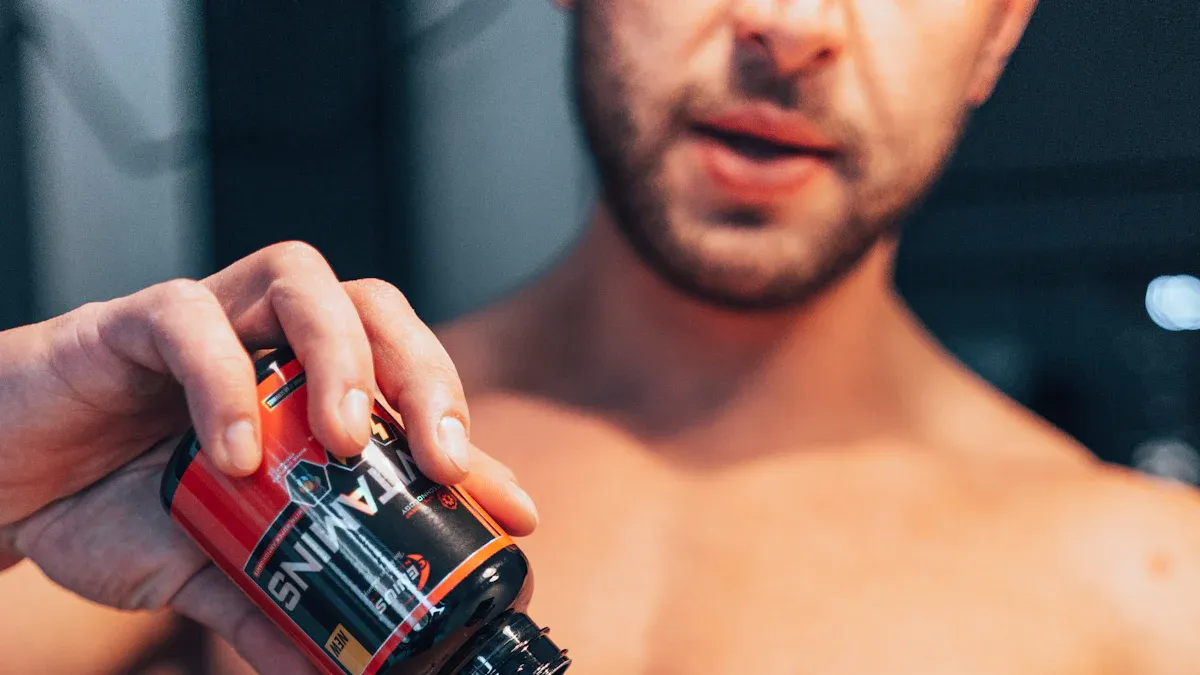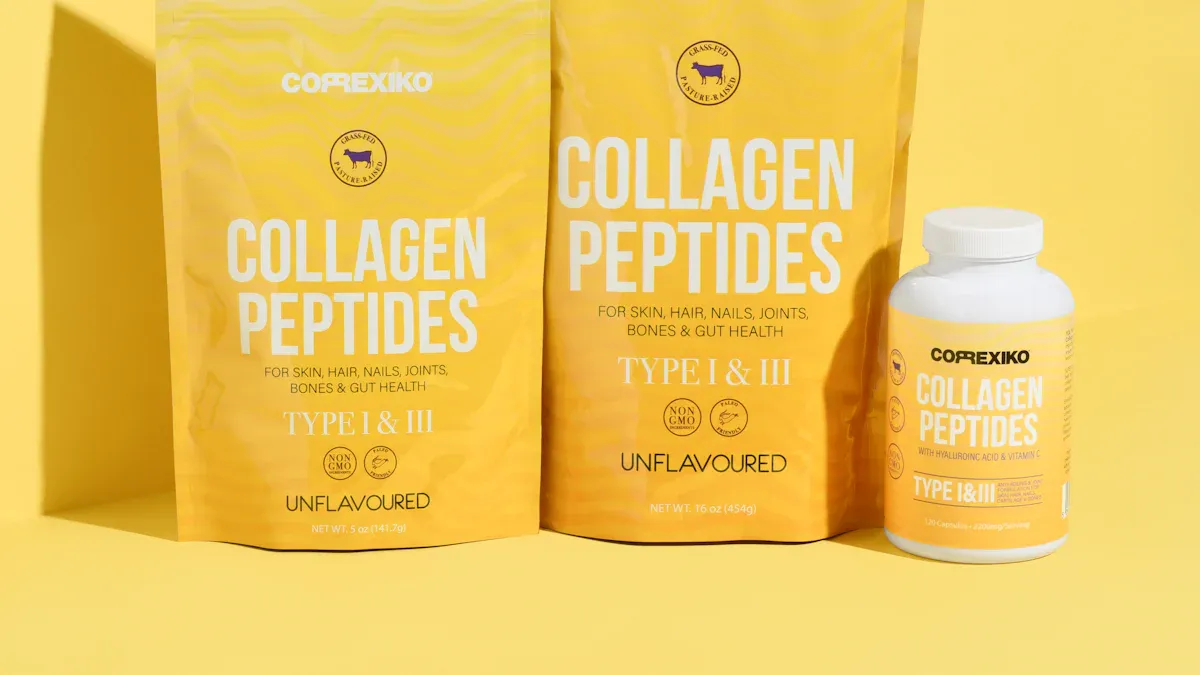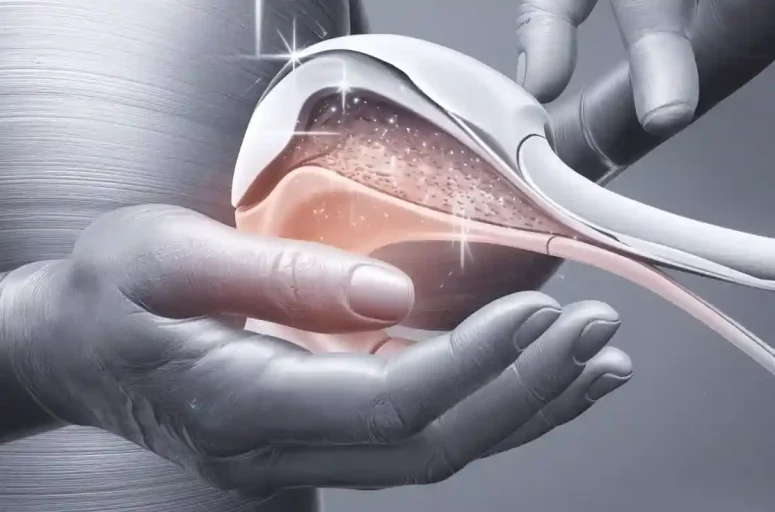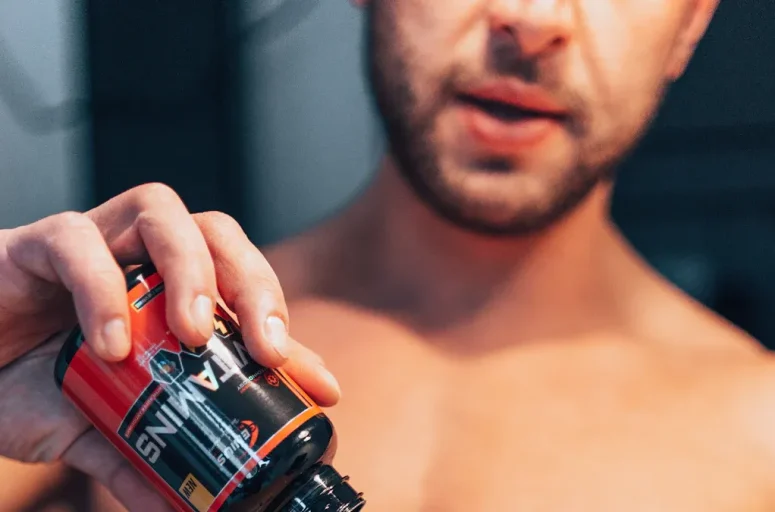
Peptide stacking is a smart method to grow muscle safely. Mixing certain peptides helps with fixing, healing, and building muscle better. But staying safe means planning well, using them right, and checking often. Always talk to a doctor before using any peptide plan to stay healthy and get the best results.
Disclaimer: This is not medical advice. Always ask your doctor before starting any peptide program.
Key Takeaways
Peptide stacking helps muscles grow and recover safely.
Pick peptides that match your goals, like CJC-1295 for growth or BPC-157 for healing.
Begin with small doses to avoid side effects and let your body adapt.
Take peptides at the right times to make them work better.
Check your progress often to see results and change your plan if needed.
Talk to a doctor before using peptides to stay safe.
Use peptides together smartly to improve their effects and grow muscles faster.
Eat healthy and exercise regularly to get the most out of peptide stacking.
What Are Peptides and How Do They Work?
Understanding Peptides
Peptides are tiny chains made of amino acids. They help build proteins in your body. These chains are important for fixing and growing muscles. Peptides are smaller than proteins, so your body absorbs them easily. This makes them great for helping muscles grow or recover after workouts.
Scientists have studied peptides to learn how they work. For example, researchers like Xu and Wang found how peptides affect cells and proteins. Their studies show that peptides can help with medicine and muscle health.
Role of Peptides in Muscle Growth
Peptides help muscles grow by fixing and building them. When you exercise, small tears happen in your muscles. Peptides repair these tears, making muscles stronger and bigger. Some peptides, like collagen, also keep tissues healthy during hard workouts.
Studies show peptides are great for muscle growth. Collagen peptides improve muscle strength and reduce fat. BPC-157 helps tendons heal faster. These benefits make peptides useful for people who want better recovery and stronger muscles.
How Peptides Work in the Body
Peptides attach to special spots in your body to start changes. For muscle growth, they increase growth hormones or help make proteins. MK-677 raises growth hormone levels, which helps muscles grow.
Collagen peptides quickly enter your blood and help make collagen. This fixes tissues and improves muscle health. Studies show collagen amino acids get absorbed well, making them effective.
Peptides work in amazing ways. Scientists like Liu and Vajjala use new tools to study them. Their research finds better ways to use peptides for muscle growth and health.
Benefits of Peptide Stacking for Muscle Growth
Better Protein Building
Peptide stacking helps your body make more proteins. Proteins are important for muscle growth. When you work out, your muscles get tiny tears. Peptides like CJC-1295 and Ipamorelin help release growth hormones. These hormones help your body fix the tears and grow bigger muscles.
Using peptides together can make them work even better. For example, combining growth hormone-releasing peptides with IGF-1 speeds up muscle growth. This mix gives your muscles the nutrients they need to grow stronger and recover faster after hard workouts.
Quicker Healing and Less Tiredness
Peptide stacking helps muscles heal faster and reduces tiredness. After a tough workout, your body needs time to fix itself. Peptides like BPC-157 and TB-500 are great for healing. They repair tissues, lower swelling, and help you recover quickly.
Studies show peptide stacking works well for recovery. For example, research comparing PeptiStrong™ to a placebo showed these results:
Study Focus | Results | Conclusion |
|---|---|---|
Big improvements in strength recovery and less tiredness | PeptiStrong™ helps recovery better than placebo |
Combining peptides with similar benefits makes recovery faster. This means less time between workouts and better performance. Always ask an expert when planning your peptide stack.
Peptide stacking boosts the effects of single peptides.
It helps you recover and perform better.
Experts can guide you to stack safely and effectively.
Stronger Effects by Combining Peptides
Using peptides together makes them work stronger. This happens because each peptide helps with different parts of muscle growth and healing. For example, mixing peptides that raise growth hormones with ones that fix tissues helps muscles grow better.
Combining peptides also helps you reach fitness goals faster. Whether you want bigger muscles, less fat, or quicker recovery, the right mix works better than using one peptide alone. This method gives your body the support it needs to grow and stay strong.
By learning how peptides work together, you can make a plan that fits your goals. This way, you can grow muscles safely and avoid side effects. It’s a smart and safe choice for people who love fitness.
Better Fat Burning and Lean Muscle Growth
Peptide stacking helps burn fat and grow muscles. The right peptides make your body better at using fat for energy. This helps you stay lean and fit while keeping your muscles strong.
Some peptides, like HGH Fragment 176-191 and CJC-1295, target fat cells. They break down stored fat and turn it into energy. This makes your body burn fat faster, especially during workouts. At the same time, these peptides protect your muscles from breaking down.
Peptides also speed up your metabolism. A faster metabolism burns calories even when you rest. For example, Ipamorelin raises growth hormones, which burns fat and fixes muscles. This helps you lose fat and build a stronger body at the same time.
Another great thing about peptides is improving insulin use. Better insulin use stops fat storage and helps muscles grow. Tesamorelin is a peptide that lowers belly fat and keeps muscles healthy.
For the best results, pair peptides with healthy food and exercise. Eating good food and staying active gives your body energy to burn fat and grow muscles. Watching your progress helps you adjust your peptide plan for better results.
Using peptides wisely helps you lose fat without losing muscle. This makes you look better, feel confident, and stay healthy. With a good plan, you can become a leaner and stronger version of yourself.
Key Strategies for Safe and Effective Peptide Stacking
Selecting the Right Peptides
Popular Peptides for Muscle Growth
Picking the right peptides is key for muscle growth. Some peptides are well-known for helping muscles grow and heal. For example, CJC-1295 and Ipamorelin boost growth hormone, which helps repair tissues. BPC-157 is another popular choice. It speeds up healing and reduces swelling.
Choose peptides that match your fitness goals. If you want bigger muscles, IGF-1 LR3 helps by building proteins. For quicker recovery, TB-500 is great for fixing tissues. These peptides work well alone but are even better when combined smartly.
Aligning Peptides with Fitness Goals
Your fitness goals should decide which peptides you use. For muscle growth, pick peptides that increase growth hormones and protein building. For burning fat and keeping muscles, HGH Fragment 176-191 works well by targeting fat cells.
If recovery is your focus, BPC-157 and TB-500 are ideal. They help you recover faster and keep your tissues healthy. Matching peptides to your workout plan helps you improve faster and reach your goals.
Proper Dosage and Administration
Starting with Low Doses
Begin with small doses to avoid side effects. This helps your body adjust and lets you see how each peptide works. For example, CJC-1295 is usually taken at 1 to 2 mg, two or three times weekly. BPC-157 is often used at 200-500 mcg daily.
Starting small also helps you find the best dose for your body. Slowly increasing the dose, if needed, ensures good results without overloading your system.
Avoiding Overuse and Toxicity
Using too much peptide can cause problems like hormone issues or skin reactions. Stick to the recommended doses and follow a schedule. For example, Tesamorelin works best before bed because it matches your body’s natural hormone cycle.
A study shows why proper dosing is important. The table below gives clear guidelines:
Peptide | Administration Frequency | |
|---|---|---|
CJC-1295 | 1 to 2 mg per injection | Two to three times per week |
BPC-157 | 200-500 mcg daily | Daily |
Tesamorelin | Before bedtime | As per individual needs |
Following these tips keeps your peptide stack safe and effective.
Timing and Cycling for Optimal Muscle Growth
Best Times to Use Peptides
Timing matters for getting the most from peptides. Taking them at the right time makes them work better. For example, CJC-1295 works best before sleep because it matches your body’s natural hormone release.
For recovery peptides like BPC-157, daily use helps repair tissues. Taking them after workouts targets damaged areas when they need it most.
Benefits of Cycling Peptides
Cycling peptides keeps them effective and lowers side effects. Use them for a set time, then take a break. This prevents your body from getting used to them and keeps them working well.
Cycling also helps you check your progress. During breaks, you can see how your body responds and adjust your plan. If you see good results, stick with the same stack. If not, change it to fit your goals better.
Studies show cycling works. Research on stacking methods, like TIPred, shows how combining and cycling peptides improves results. By using different peptides and cycling them, you can grow muscles safely and steadily.
Tip: Always ask a doctor before starting or changing your peptide plan. They can help you stay safe and reach your goals.
Monitoring and Adjusting Peptide Stacks
Tracking Progress and Side Effects
Watching your progress is very important with peptide stacks. It shows how your body reacts and keeps you moving toward your goals. Checking often also helps you spot and fix side effects early.
Here are some easy ways to track progress:
Get blood tests before and after using peptides. This checks health markers like cholesterol and insulin.
Use a DEXA scan to see muscle changes. For example, one test showed eight pounds of muscle gained in seven weeks.
Try a glucose monitor to track blood sugar. This helps you adjust your diet to match your peptide plan.
It’s also important to watch for side effects. Common problems include skin reactions or hormone changes. Write down any strange symptoms like swelling, tiredness, or mood swings. This helps you and your doctor decide what to do next.
Tip: If side effects don’t go away, talk to a doctor. Acting early keeps you safe and helps you get better results.
Modifying Stacks Based on Results
Changing your peptide stack based on results is smart. If things are going well, stick with your plan. But if progress slows or side effects happen, it’s time to adjust.
First, check your fitness goals. For example, if you want more muscle but are losing fat instead, change your peptides. Adding IGF-1 LR3 can help build muscle faster.
Notice how your body reacts to each peptide. If one causes problems, switch to a safer option. For instance, if CJC-1295 causes swelling, try Ipamorelin instead. It supports growth hormones without the same issues.
Use tools like DEXA scans and blood tests to check progress. These give clear data to guide changes. For example, better heart health during a cycle shows your stack is working. If there’s no improvement, adjust the dose of certain peptides.
Note: Don’t change your stack without asking a doctor. Doing it alone can cause problems. A doctor can help you make safe and smart changes.
By tracking progress and making careful changes, you get the most from peptide stacking. This helps you reach your goals while staying healthy and safe.
Avoiding Side Effects of Peptide Stacking
Common Side Effects and Risks
Peptide stacking can help a lot, but it has risks. Knowing these risks keeps you safe and helps you decide wisely.
Injection Site Reactions
Using peptides might cause redness or swelling where injected. This happens as your body gets used to the peptide. Bad injection methods or dirty needles can make it worse.
To avoid this, always use clean tools and follow safe steps. Change injection spots often to prevent irritation. If swelling or redness doesn’t go away, see a doctor right away.
Hormonal Imbalances
Peptides that affect growth hormones can upset your body’s balance. Using too much can cause high hormone levels, leading to joint pain or swelling. In some cases, it may even cause unusual bone growth.
Other problems include insulin resistance, which affects blood sugar control. High doses might also stop your body from making its own hormones, causing long-term issues.
Common side effects of peptides include:
Joint pain from fast tissue growth.
Swelling in hands or face (edema).
Carpal tunnel syndrome from fluid buildup.
High blood pressure due to sodium retention.
Headaches, nausea, or changes in cholesterol levels.
Knowing these risks helps you use peptides safely and avoid problems.
Preventative Measures for Safe Use
Consulting Healthcare Professionals
Talk to a doctor before starting any peptide plan. They can check your health, suggest the right peptides, and guide you on safe doses. A doctor’s advice helps you reach your goals without risking your health.
Doctors can also track your progress and adjust your plan if needed. Regular visits help catch side effects early and keep you on the right path.
Regular Health Checkups
Health checkups are very important when using peptides. Blood tests can check hormone levels and other markers to ensure your body is doing well. For example, checking insulin sensitivity can prevent problems like insulin resistance.
DEXA scans are also helpful. They show muscle growth and fat loss, giving you a clear view of your progress. Regular checkups keep your health in focus and give you peace of mind.
Tip: Visit your doctor every few months to check how peptides affect your body.
Ensuring Quality and Purity
Choosing Trusted Suppliers
Good-quality peptides are safer and work better. Always buy from trusted sellers with a good reputation. Look for companies that test their products for purity and strength.
Avoid buying from unknown sources or shady websites. Low-quality peptides might have harmful ingredients or wrong doses, increasing risks.
Avoiding Contaminated Products
Dirty peptides can cause infections or allergic reactions. To avoid this, check labels and storage instructions. Reliable sellers provide details like batch numbers and expiration dates.
Store peptides properly, like keeping them in the fridge if needed. This keeps them effective and safe to use.
Note: Buying high-quality peptides protects your health and makes peptide stacking more effective.
Example Peptide Stacks for Optimal Muscle Growth

Beginner-Friendly Peptide Stacks
Simple Muscle Growth Stack
If you’re new to peptides, start with an easy plan. A good beginner stack includes CJC-1295 and Ipamorelin. These two work together to boost growth hormones. This helps your body fix tissues and grow muscles.
CJC-1295: Take 1 mg twice a week to increase growth hormones.
Ipamorelin: Use 200 mcg daily to help recovery and reduce tiredness.
This stack is simple and shows results in weeks. It’s great for beginners who want muscle growth without overloading their body.
Recovery-Focused Stack
For quicker recovery after workouts, use BPC-157 and TB-500. These peptides heal damaged tissues, lower swelling, and speed up recovery.
BPC-157: Take 250 mcg daily to fix muscle tears and improve joints.
TB-500: Use 2 mg weekly to help tissue repair and flexibility.
This stack helps you recover faster, so you can train more often. It’s perfect for beginners focusing on healing while building muscle.
Advanced Peptide Stacks
High-Performance Muscle Building Stack
Experienced users can try a stronger stack for big muscle gains. Combine IGF-1 LR3, CJC-1295, and Ipamorelin for better results.
IGF-1 LR3: Take 50 mcg daily to help build proteins and muscles.
CJC-1295: Use 2 mg weekly to keep growth hormone levels high.
Ipamorelin: Take 300 mcg daily to support recovery and burn fat.
This stack helps you gain muscle fast and perform better. It’s for those ready to push their fitness limits.
Fat Loss and Muscle Definition Stack
For advanced users wanting less fat and leaner muscles, try HGH Fragment 176-191, Tesamorelin, and CJC-1295.
HGH Fragment 176-191: Take 250 mcg daily to burn fat and boost energy.
Tesamorelin: Use 2 mg before bed to cut belly fat and tone muscles.
CJC-1295: Take 1 mg twice weekly to help growth and recovery.
This stack burns fat while keeping muscles strong. Pair it with healthy food and exercise for the best results.
Customizing Peptide Stacks
Tailoring Stacks to Individual Goals
Your peptide stack should match your goals. For bigger muscles, use IGF-1 LR3 and CJC-1295. For recovery, focus on BPC-157 and TB-500. Adjust doses as needed and ask a doctor for advice.
Incorporating Diet and Supplements
Peptides work better with good food and supplements. Eat protein-rich meals to help muscles grow and heal. Add supplements like creatine and BCAAs for extra benefits.
Tip: Drink water and eat balanced meals to get the most from your peptide stack.
By personalizing your stack and eating well, you can safely grow muscles and stay healthy.
Peptide stacking is a smart way to grow muscles safely. Picking the right peptides and using the correct amounts helps you reach fitness goals. Checking your health often keeps your body strong during the process. Always ask a doctor to make a plan that fits your needs. This method lowers risks and helps you succeed in staying fit for a long time.
FAQ
What are peptides, and how are they different from proteins?
Peptides are tiny amino acid chains, while proteins are much longer. Peptides are absorbed faster by your body because they are smaller. This makes them great for helping muscles grow and recover quickly.
Can you stack peptides without medical supervision?
No, you should not. Always talk to a doctor before starting peptide stacking. They can help you use the right doses and check your progress to stay safe.
How long does it take to see results from peptide stacking?
It depends on your goals and the peptides you use. Most people see muscle growth or recovery improvements in 4–8 weeks. Using peptides properly and regularly is very important.
Are peptide stacks safe for beginners?
Yes, beginner stacks like CJC-1295 and Ipamorelin are safe if used correctly. Start with small doses and follow your doctor’s advice to avoid problems.
Can peptides help with fat loss?
Yes, peptides like HGH Fragment 176-191 help burn fat and speed up metabolism. They work best when paired with exercise and healthy eating to keep muscles strong.
Do peptides have side effects?
Some side effects include redness, swelling, or hormone changes. Watching your body and talking to a doctor can help you handle or avoid these problems.
How do you store peptides?
Keep peptides in the fridge to keep them working well. Follow the instructions from the supplier to store them safely and effectively.
Can you combine peptides with supplements?
Yes, using peptides with supplements like creatine or BCAAs can improve results. Eating healthy and drinking water also helps muscles grow and recover better.
Tip: Always ask a doctor before adding supplements to your peptide plan.



3 comments